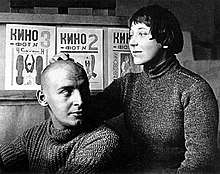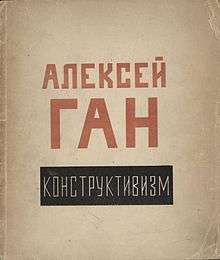Kino-Fot
Kino-Fot (Russian: Кино-фот) was a Russian magazine dedicated to cinema produced from 1922 - 1923 under the editorship of Aleksei Gan. A total of six issues of the magazine were produced, five in 1922 with a sixth in 1923. The contributors included Vladimir Mayakovsky, Dziga Vertov and Lev Kuleshov.[1] It was, for a while, the principal journal of the emerging cinematic industry in the Soviet Union.[2]

Issue 1, 25–31 August 1922
The first issue contained Vertov's statement "We: Variant of a Manifesto" which commenced with a distinction between "kinoks" and other approaches to the emergent cinematic industry:
- "We call ourselves kinoks – as opposed to "cinematographers", a herd of junkmen doing rather well peddling their rags.
- We see no connection between true kinochestvo and the cunning and calculation of the profiteers.
- We consider the psychological Russo-German film-drama – weighed down with apparitions and childhood memories – an absurdity."[3]
Issue 3, 19–25 September 1922
This issue included drawings by Varvara Stepanova, a drawing by Alexander Rodchenko of a proposed building for the All-Russian Congress of Soviets and an article by him about Charlie Chaplin.
Issue 6, 8 January 1923
This issue included an article by Vertov, "Kino-Pravda" which related to a series of documentaries Kino-Pravda the first of which had been released in June 1922.
References
- "Kino-fot - Monoskop". monoskop.org. Retrieved 15 December 2018.
- Lodder, Christina (December 2000). "Promoting Constructivism: Kino-fot and Rodchenko's move into photography". History of Photography. 24 (4): 292–299. doi:10.1080/03087298.2000.10443423. ISSN 0308-7298.
- "We: Variant of a Manifesto" (PDF). monoskop.org.
